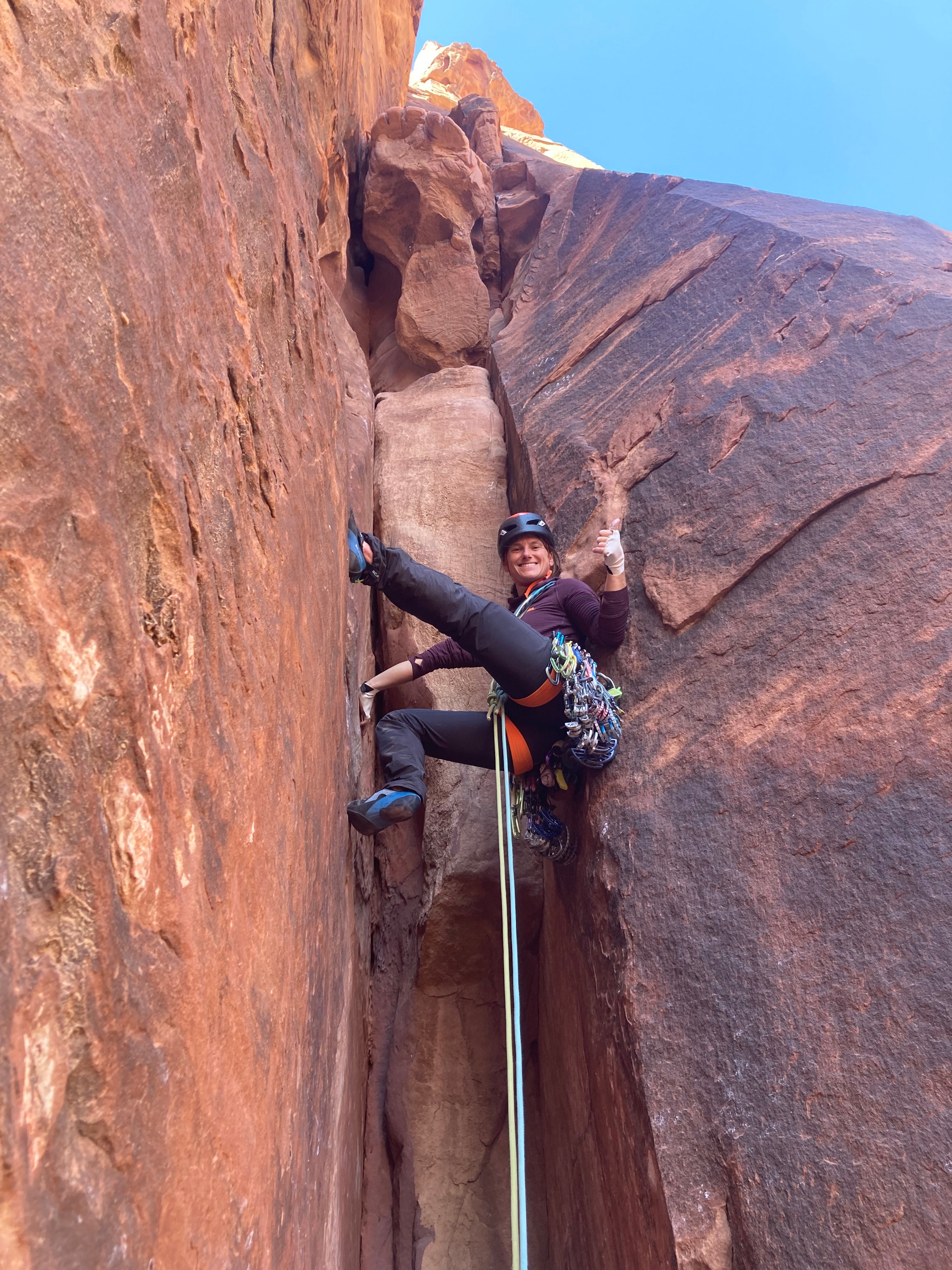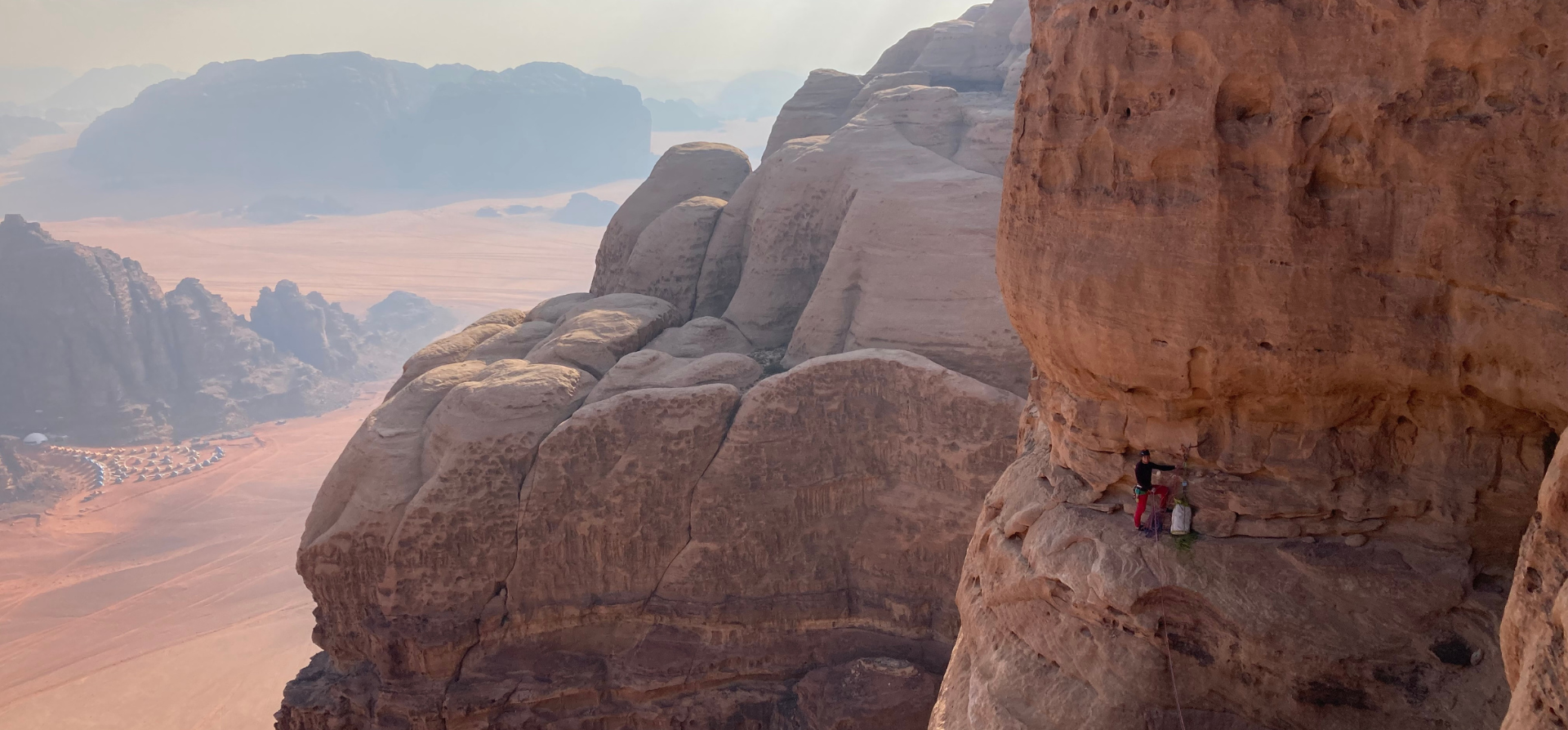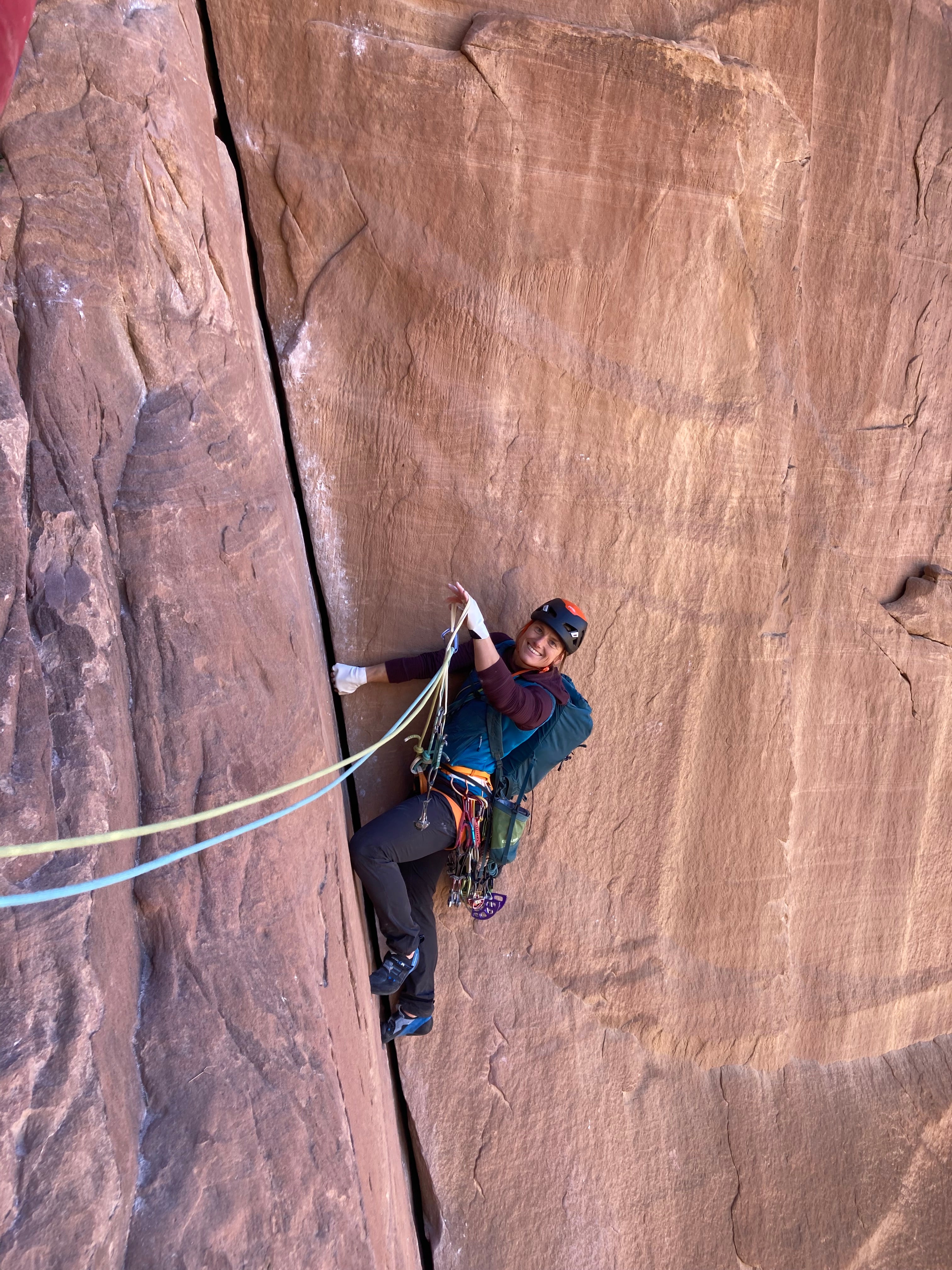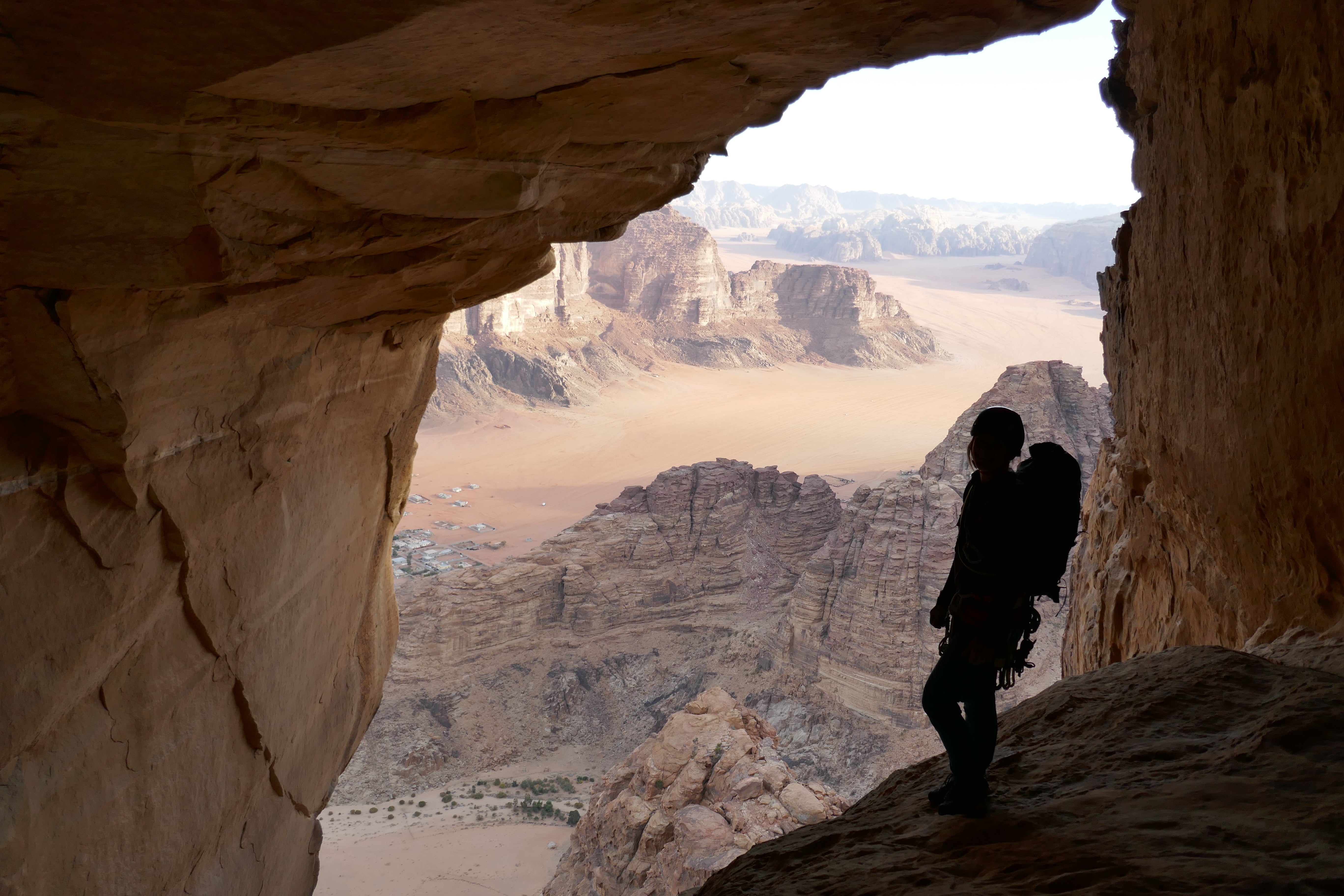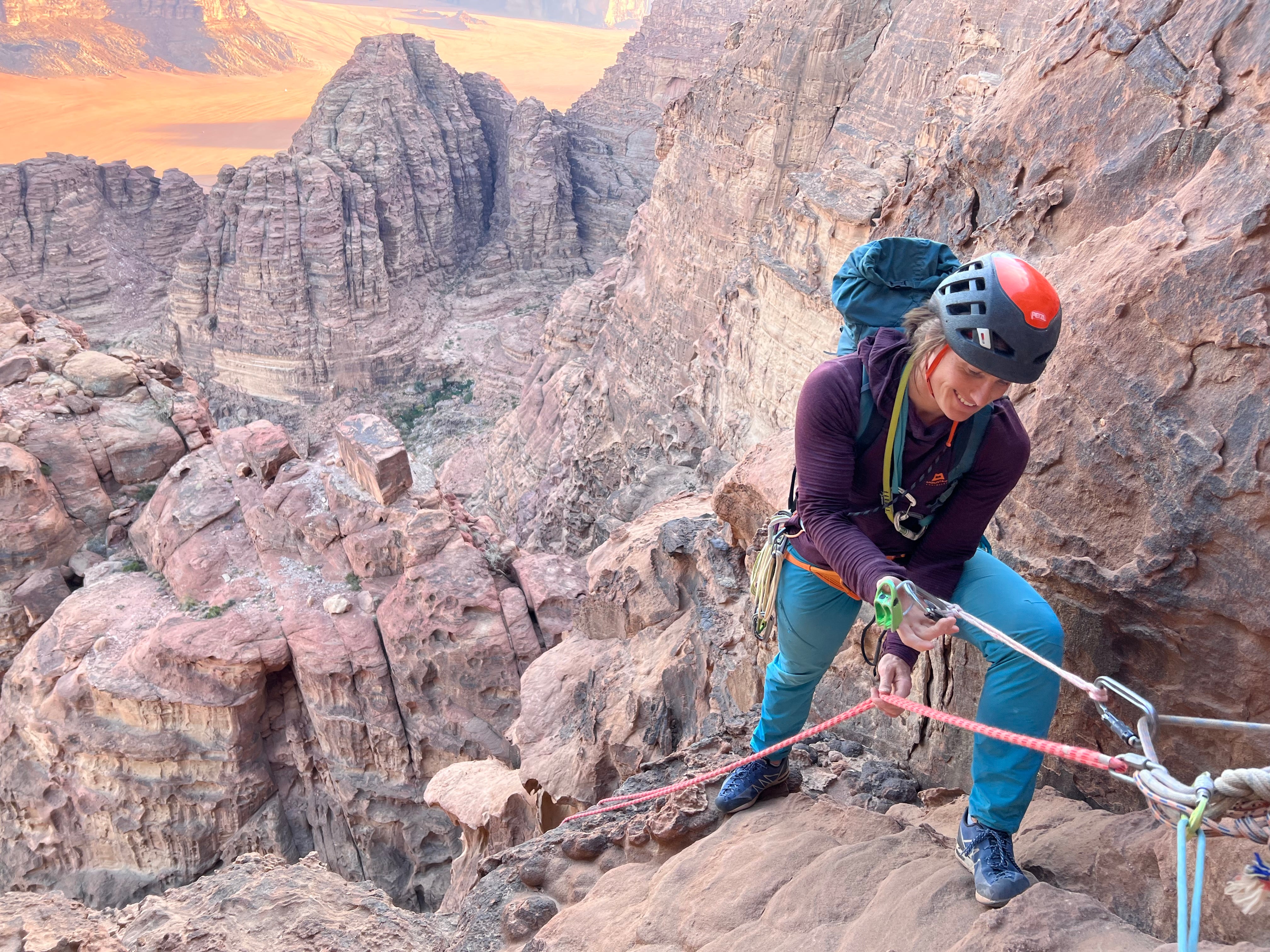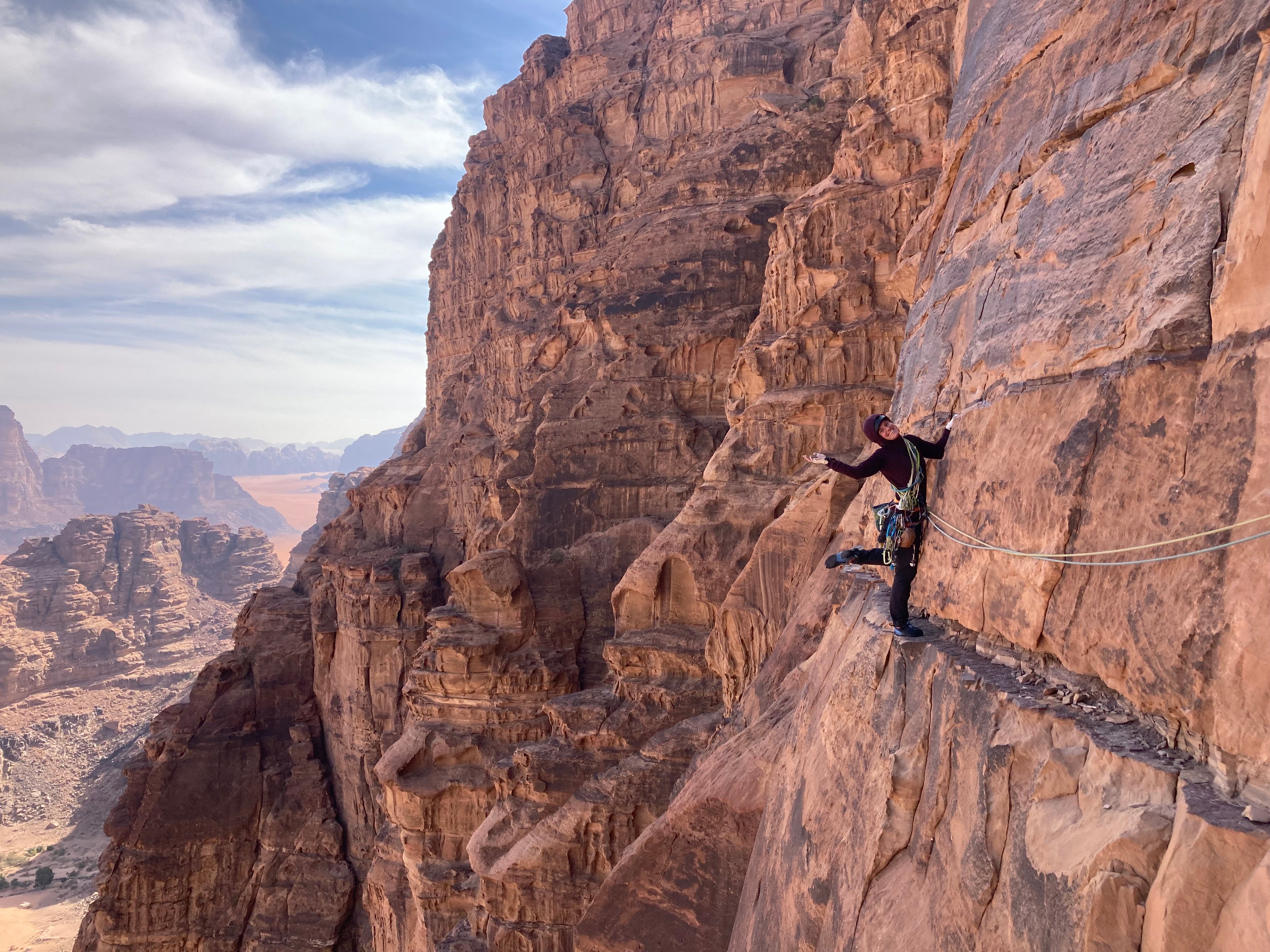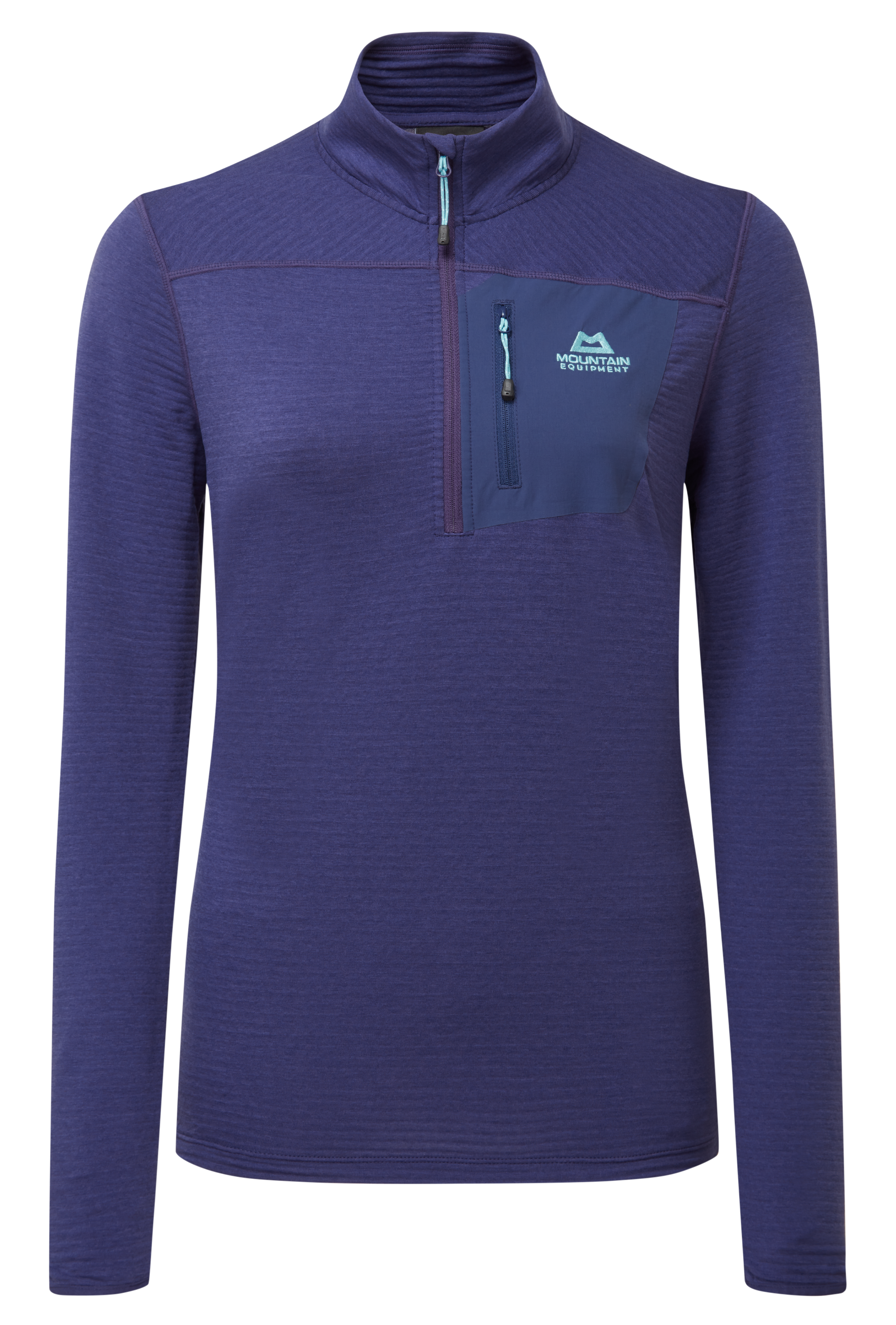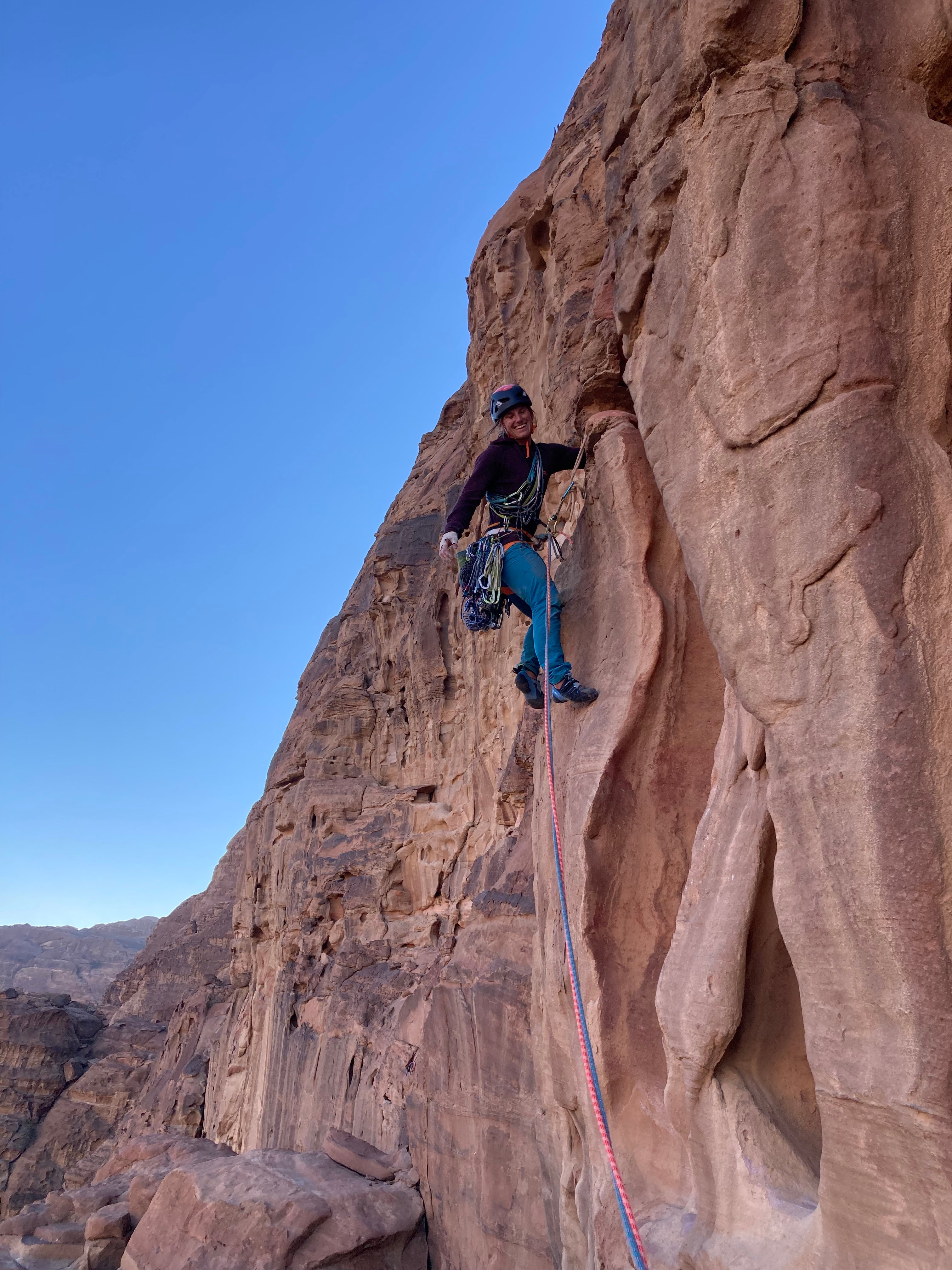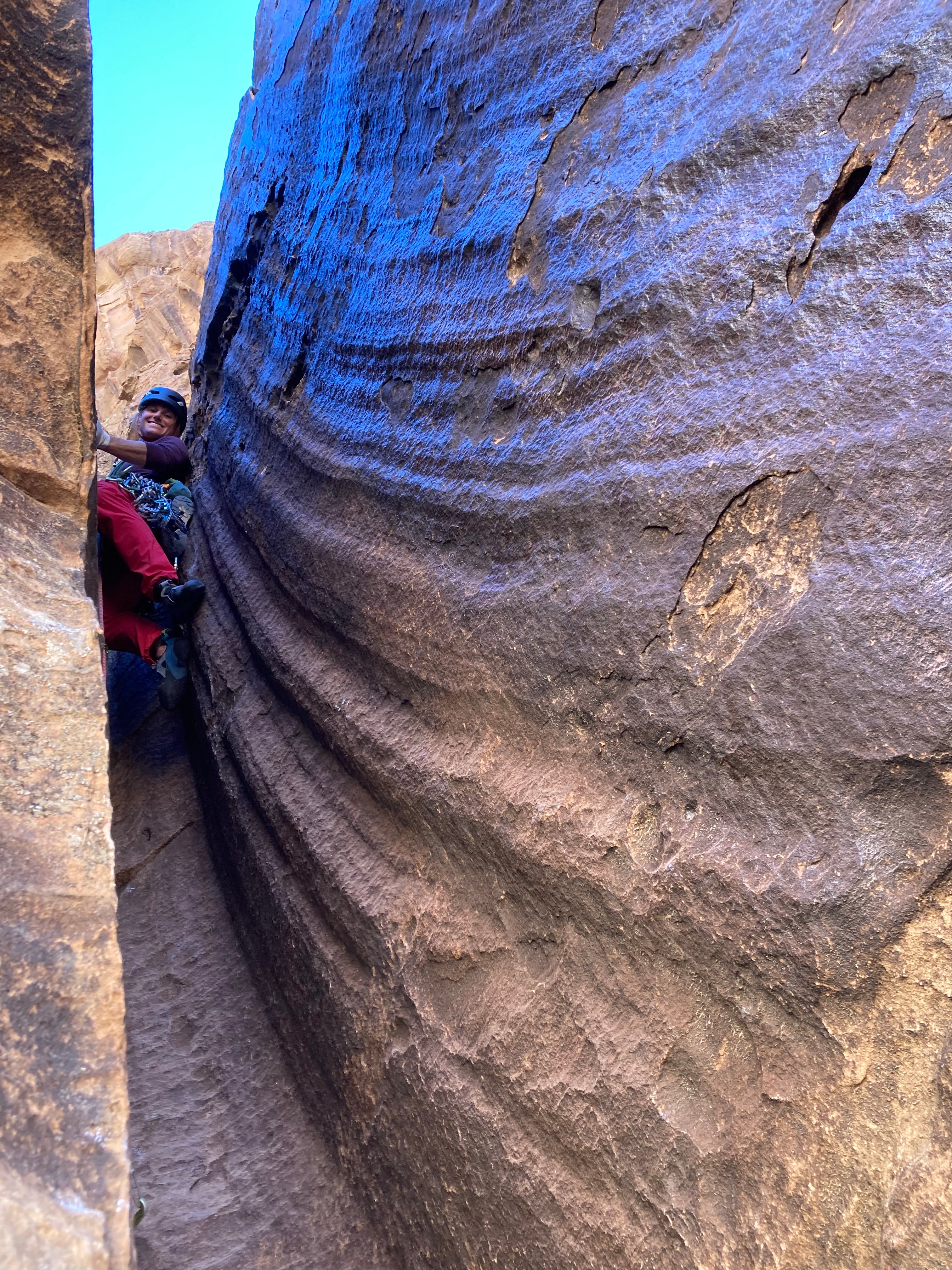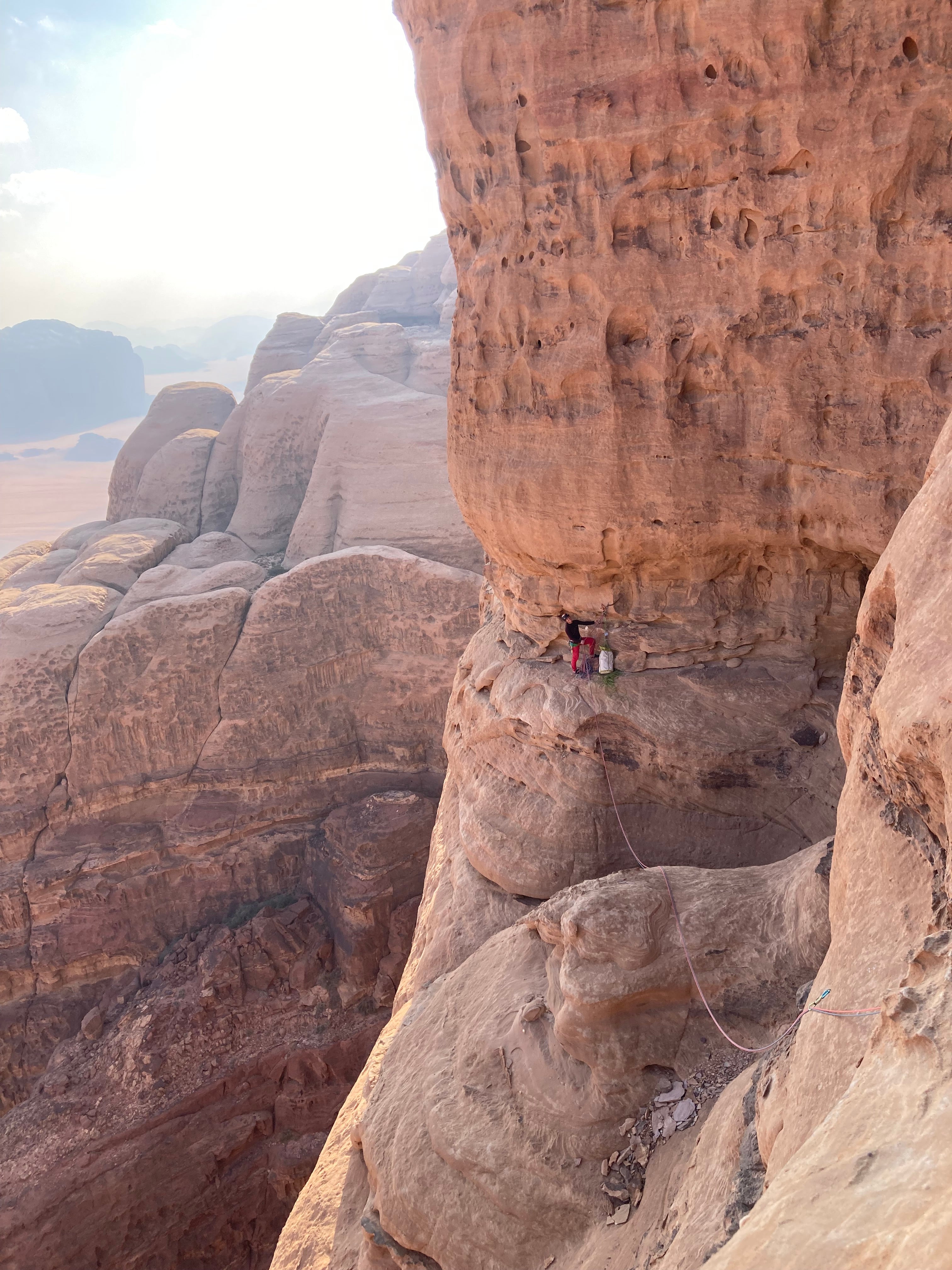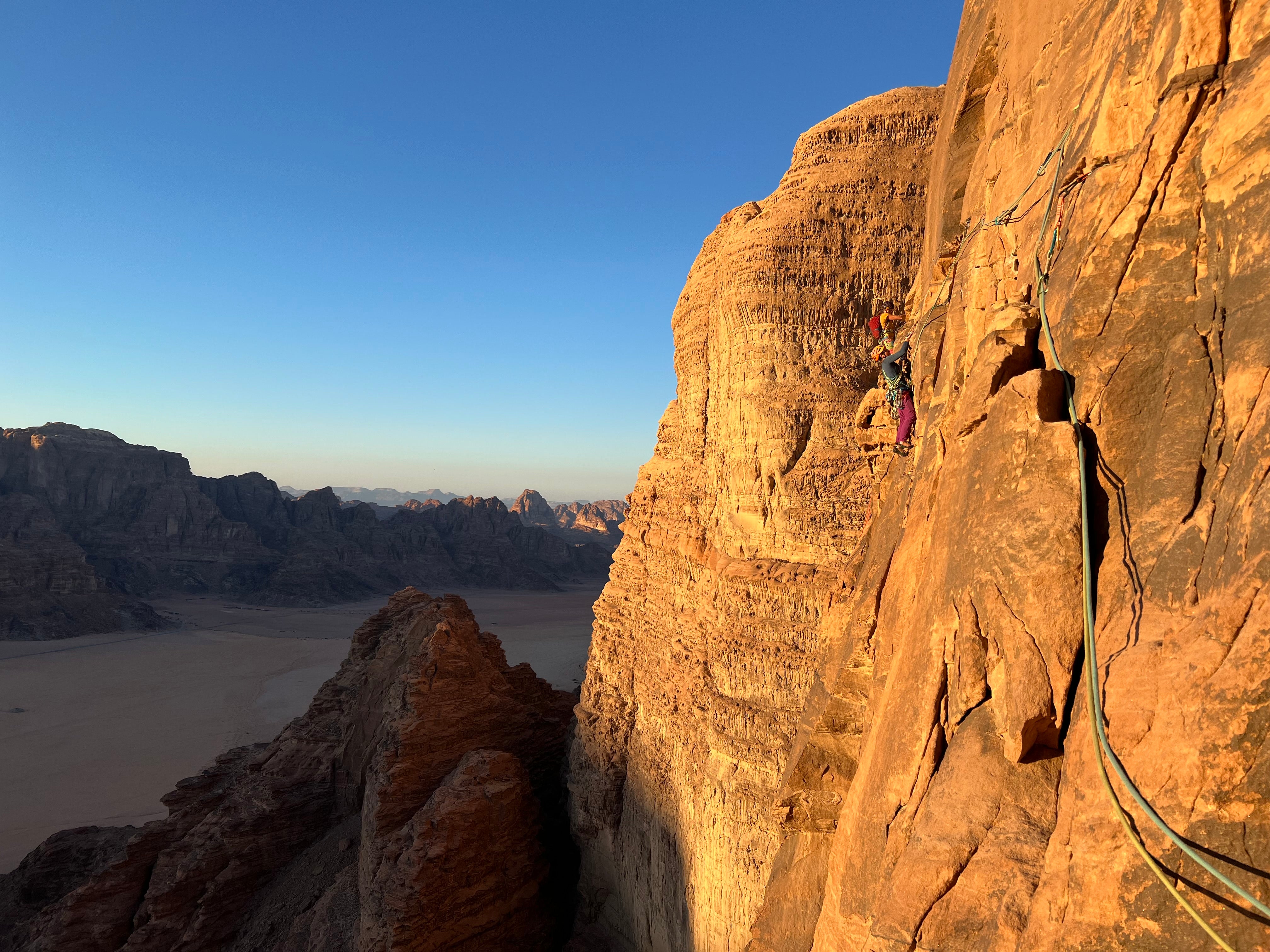A fairytale sandstone world
Words by Susanne Süßmeier
High, steep walls with bizarre sandstone domes rise up around us. A little off a logical line along a perfect intersection. First over green granite, which soon is replaced by sandstone, we hike along the Karazeh Canyon. Every now and then you have to take your hands out of your trouser pockets and climb up a few meters. Then we are under our current line: the "Rock Fascination", first climbed by Albert Precht and colleagues. Through Chimneys, intersections and cracks, along honeycombs and Sandsteinsintern it goes in 15 pitches, between sand and sandstone, out of the canyon. Secured with mobile Safety devices and slings, a few old slings point the way. The Austrian Albert Precht, known for his bolt-free first ascent style, left some adventurous routes here in Wadi Rum. If you want to go rock climbing in Wadi Rum, you should feel comfortable with trad climbing. For a long time, there was a strict climbing ethic, which mainly set natural safety points and used as few bolts as possible. In the soft sandstone, a portion of experience and a lot of glue are required to set them safely anyway…
Back to rock fascination: just before 4 p.m., two hours before nightfall, we sit at the exit, knowing that the hardest part is yet to come: the complex descent. The Summit plateaus of the mountains consist of many different high sandstone domes. Once you have overcome one, often over steep slabs, the next one after that comes. In between there is always a ditch with vertical walls, which blocks the way. The darkness has now caught up with us - but we only have to rappel down the "Secret Garden" route. However, “only” becomes three hours, most of which we spend on ropes looking for the next abseil. Naturally according to the style, abseiling on slings... we are glad when our hosts us meet us in the jeep and make us the daily “chicken and rice” dinner.
A little less adventure is offered by numerous classics, which can also be abseiled down. We preferred to do this on the first climbing days. It also took a few pitches until we got used to the desert sandstone. "If all the walls from here were good rock quality - it would probably be one of the world's best climbing areas" sums up Elad Omer, an Israeli mountain guide and probably currently one of the best area experts. Unfortunately, only a small part of the sandstone is enjoyable to climb….
But not only the European climbers brought climbing to Wadi Rum. The local Bedouin have many challenging climbed routes. One of them is the “Al Thalamyyiah” route, the start of which we have already seen from the descent of the “Know the Black Magic” route at the Black Tower. The sight of the canyon in which the route going up is terrific. The steep ones look artistic, reminiscent of ornaments on a decorated church façade. After noon we set off with a few litres of water, the best falafel from the small falafel snack bar in the village, sleeping bag, sleeping pad, one rope, one Packed ab-line and 3 Friends. Again and again our gaze wanders these impressive walls, while we climb with a rope, but mostly without a rope in “stimulating” climbing, airy and exposed. Sometimes we wish we had a little more geological understanding to understand the creation of this fairytale landscape. After a basalt plateau we reach the smooth-polished domes, which here around Wadi Rum cover the upper third of each mountain. Finding your way doesn't get any easier, only a few cairns point the way.
Shortly after the setting sun has coloured the landscape fiery red, we reach a big sandy plateau. There we look for a nice spot for our night's camp. The crackling of listening to the campfire, we cuddle up in our sleeping bags. It's dead quiet up there, apart from a few little birds, we didn’t see any animals all day, although there were occasional traces of droppings to testify their presence. Even if finding our way the next day is much easier for us, the path to the summit still drags a little. A few hours later we are back in the background noise of the village. Five times a day the two imams call for prayer, and in addition to roosters, donkeys, the sound of the water tanker and the "Bedouin taxis" whizzing from the village into the desert, the camels also have an unmistakable vocal organ.
We take it easy the next day, trading one of our old ropes for one Camel ride in the desert and make plans for the last week in Jordan. Three more Climbing days should follow before we want to drive from Aqaba to Amman with a rental car, to experience a little more of the country and culture.
Susi's guide to climbing in Jordan
The climbing
Wadi Rum is situated on a granite and basalt plateau at 800m and is surrounded by sandstone mountains. Also, the Jebel Rum, at 1734m the second highest mountain in Jordan, is directly west of the village, the ascent takes just 20 minutes. The climbing in the sandstone is very diverse. There are cracks, corners, chimneys, wall and slab climbing and steep 3D climbing. The more exciting the structures look, the more adventurous the climbing- the "Honeycomb" usually sounds hollower than one would like.
The sinters are also a sandy experience – still impressive to climb. It needs a bit of warming up with the sandstone and the realization that the optically impressive structures from a climbing point of view also are impressive but not ideal.
Many pitches can be secured in the classic way with friends, nuts and slings. You usually end somewhere on the plateaus, it's definitely worth going on to a summit for the view!
Fixed material: The most trustworthy material are definitely the glued hooks, you can also find bolts, snap hooks in drilled holes and drilled slings. Classic hooks are not said to have a particularly long service life. The descents are often very complex and sometimes just as demanding as climbing.
-
Gear
- Half ropes 60m, at least one spare strand - the sandstone causes a lot of wear and tear and there is nothing to buy on site
- A double set of friends from Camalot #0.2 to #5 or one #5 and one #6
- A well-stocked set of nuts, we also had the Ballnuts from Camp
- Thread loops
- Cord and maillons for abseiling
-
Climbing guides and topos
- "Treks & Climbs in Wadi Rum Jordan" by Tony Howard. However, this one is out of print so must be borrowed from someone. A PDF version is in circulation.
- “Rock around the world” by Thierry Souchard, in French and English authored guide. It includes a well-described selection of very rewarding routes
- "Parois de Legende" by Stéphanie Bodet and Arnaud Petit also includes 5 routes Wadi Rum. But it's also out of print.
- On Camptocamp.org we found more valuable information
In the rest house there was probably a collection of all topos. Unfortunately, since Corona, the "Resthouse" is closed. Nobody could tell us whether the Resthouse would open again. At Hamdan's House however, there were copies of the Legendary topo Collection. Tobias Wolf has also created a small topo collection on his homepage (https://kayakandclimb.blogspot.com/ ). A new selection guide is in the works, I don’t know when it will be ready.
-
Season
November, February and March are considered the climbing months in Wadi Rum. In December and January the days are relatively short with 10 hours
and the chance of rain is higher.
Also, the weather is subject to great fluctuations in these months, in December 2022 it was about 10°C too warm for the
season, instead of the usual 15°C we had around 21°C. In the sun, dark red Sandstone is pretty warm. -
Getting there
We found direct flights via low-cost airlines such as Ryanair and Wizzair from Memmingen, Vienna, Bergamo,... - on different days of the week. From Memmingen, the flight to Amman took 4.5 hours.
Wadi Rum is an hour's drive from Aqaba and four hours' drive from Amman. A Taxi transfer is fastest and cost us 25JD to Aqaba and 115JD from Amman. The taxi was organized by our hosts. Rental cars are available in Amman and Aqaba, Avis offers also the possibility to return a car at another location. In Wadi Rum you don't need a car unless you rent a 4x4 jeep and drive through the desert yourself. There are also public buses, which are cheaper but take longer. -
Money and communication
Cash can be exchanged for the first time shortly after getting off the plane. However, the exchange rate did not seem very favourable to us. Withdrawing money from the ATM was the better option. In 2022, 1 JD was around €1.30.
Orange offers travellers prepaid tariffs for 15 JD and 30 JD. (20/60 GB internet, domestic unlimited minutes and messages, international 20/60 minutes and 10/30 SMS). In our Accommodation the WIFI was impeccable and our own data was not required. Around the village is good reception, further in the desert there is no reception. -
On site
The not so small village of Wadi Rum is located at the end of a tarred road street, behind it you can only go deeper into the desert with 4x4 jeeps. There are 2 mosques which loudly call to pray (oropax recommended for sensitive ears when sleeping), 2 Restaurants and a falafel snack bar and countless small supermarkets that provide you with most essentials. The village can be seen quickly and in addition to the springs and a Nabataean temple there is another clothing store with traditional clothing and Chinese imports, a store with the usual Jordanian souvenirs and the "Burdah Woman’s Cooperative". Only women, who are otherwise not to be seen in public life, work there and provide arts and crafts.
-
Accommodation and food
There are a variety of accommodation options in town. We were at Shaker from “Arabian Nights", but also "Hamdans House" and the "Oryx Hostel" seemed very nice. The latter two covered with plants around the accommodation. There are many more, basically you have to be careful when booking that you rent in the village. Half board came to us at 17 JD per day. On Booking.com you can find some accommodations.
Dinner was almost exclusively chicken and rice, but that seems to be the case throughout the village (It was also the name of a new route at the Black Tower in 2014). Also, in the two "restaurants" the selection is quite limited and differs from the good food, which we got served elsewhere. The falafel man from Egypt (the small falafel stand just in front of the "Rum Castle Restaurant") lovingly makes incredibly good falafel sandwiches.
Apparently, there are gas cartridges for gas stoves at the Carrefour in Amman. Our host Shaker also had cooking gear to borrow should you be staying in Barrah Canyon for a few days. It is best to ask at the chosen accommodation. -
Prices/Paying
Wadi Rum is very touristy and hence the prices. In the Rum Castle Restaurant, however, as climbers we got lower prices. Bargaining is worthwhile when it comes to the classic “souvenirs” and on the market. It's best to only buy at the end, when you know how much something costs – from Aqaba to Amman it’s the same everywhere anyway.
-
Travel and Sightseeing
If you want to travel a little more in Jordan, the Jordan Pass is recommended. It grants free entry to many attractions, including Wadi Rum and Petra, as well as visa fees benefits. The thing, which you can buy online before you arrive, costs 70 JD, It is best to have it with you in printed form.
Aqaba on the Red Sea
Worth it for snorkelling. In the Gulf of Aqaba, the corals are not yet of the Coral bleaching affected and 20 meters from the beach surprises you with the colourful underwater world. The equipment can be rented for 5 JD (possibly trade). We were at "Japanese Garden", that was recommended.On the first street off Prince Mohammad Street turns south (above K. Hussein Street) is one seafood restaurant after another. Chilled in Styrofoam boxes, the fresh fish waits to be selected for preparation. You can also choose the type of preparation - grilled or deep-fried.
PetraTwo hours’ drive from Wadi Rum. The ancient capital of the Nabataeans impresses with its Tomb temples carved directly into the rock. The rock city is one of the most important Tourist attractions in Jordan. That's how it is there, and there are also many on site pushy traders who want to offer you something. But we didn’t notice that in other places in Jordan.
The Dead Sea
You don't have to say much - Lying on the water without swimming and reading the newspaper in pleasantly warm water, that’s something to look at - as long as it still exists, the water level drops every year for various reasons. It is important to take a shower afterwards. We were down south at the white salt beaches with makeshift Shower and had brought some bottles of water to shower off.
There are hot springs near the Dead Sea - we stayed in Ma'an, (15JD per person). We came late, contrary to what the guidebook says, they were still open and it wasn't excessively busy. I'm sure that with more thorough research or with a little more time. There are also cheaper options in the area. -
Good to know
Old ropes are very popular. On the streets of the village, people often ask if you want to give away or sell one’s rope. They said they needed them for their camels. We traded an old rope for an hour's camel riding. The proud owner of the rope then sold the meters he did not need for 1 JD/meter.
Good shoes and (warm) jackets as well as other climbing equipment are also just as popular with the locals– you can only buy Chinese goods and classic Bedouin clothing there.
Old snowboards are used for sand surfing (or rather sliding) and are just as difficult to acquire for the locals.
In tourism, it seemed to me that the locals don't earn badly and are willing to pay to pay for items brought along.
Recommended Kit
Itinerary and Route list
Travel dates: 28/11/2022-19/12/2022
Day 1: Visited Petra because it was raining. Wetness makes the sandstone less stable.
Day 2: "In the court of the crimson King", 6a, Burdah east face, no fixed material, descent over the north ridge past the rock bridge. Remote piece of rock in the far east of the territory. Not a classic.
Day 3: “The Beauty” 6b and “Alain and his Perverse Frog”, 6a, Jebel around Ejil. The impressive canyon, which is worth a visit in itself, you climb approx. an hour too. "The Beauty", an absolute classic, has shade until the afternoon. For "The Beauty" it is recommended to use 2x Camalot #5 or once #5 and take #6 with you for the last pitch. The belays are glued, you can also rope down over them. If you have enough time you can still climb "Alain..." or "Priez pour nous". At "Alain..." there is little fixed material. Abseiling is also done here via “The Beauty”.
Day 4: “Lionhart”, 6b, Abu Aina Towers. Another classic, with adhesive hooks on the belays for abseiling over the route. Late November it is in the sun until noon. We only got on at 12 a.m.
Day 5: "Flight of Fancy", 6b and "Troubadour", 6b at Jebel Rum, East Face. Both tours offer grandiose pitches. Partially glued belays. With the "Troubadour" you can use the "Voie du Coeur" with a 7a pitch (many bolts). Predictive rope management for the 6c (3rd pitch). Advantageously, the bolts are distributed somewhat to the left and right…. Ideal routes (as well as the neighbouring routes) for shorter climbing days with little ascent or to get used to.
Day 6: "Black Magic", 5c, Dark Tower. No fixed material in the lower part, only in the upper part, because there is abseiling over the route. The descent in the canyon gives a tiny Foretaste of the “Al Thalamiyyah” route to Jebel Rum. The source at which you pass by is incredibly beautiful and compared to "Lawrence Spring" without any tourists.
Day 7: "The Star of Abu Judaidah", 6c and "Merlin's Wall", 6a in Barrah Canyon, two of the classic there. A return trip cost 80 JD in 2022, which is why many spend a few days there. In the morning we climbed "The Star..." but on recommendation without the last 5a - pitch and after an extended lunch break, the "Merlin’s Wall". The extension of we really liked Arnauld Petit (P5 and P6). Both routes have glued belays, over which one abseils.
Day 8: "La Guerre Sainte" 7b, Nassrani SE wall. The very best pleasure climbing, exclusively quickdraws necessary!
Day 9: Rest day in Aqaba: beach chairs, snorkelling and eating fresh fish
Day 10: "Queen of the desert", 7a, Jebel Rum east face. Another fun route that only requires 3 friends apart from quickdraws (where it crosses other routes). Varied climbing - first flat wall climbing, then ingeniously steep, and finally in the finishing pitches you can really admire how much Friction that sandstone gives! We had received the tip from the first climbers to do this route as the first of the longer routes on this wall, since the abseiling has been set up and is very pleasant and also makes sense for some neighbouring tours.
Day 11: “Inshallah factor”. Highlight: the end in a huge fireplace, in which you have 2 climbs up pitches in the best rock. A 60m rope strand is sufficient for abseiling from the "Eye of Allah" into the Great Siq. About 7 descents, all shorter than 30m. On the last abseil before pulling the rope, check out the further way, because you can continue abseiling a little diagonally, towards the inside of the gorge, behind a hump and thus save yourself some sporty climbing. After a spooky stride, the impressive gorge goes a little further inward. It gives a foretaste of the Hamads route, a possible ascent of Jebel Rum. Where you meet it, by a small tree, you follow its ascent route up the red ridge and directly orographically to the right following the cairns to two rappels, which are also each with a 60m strand are possible.
Day 12 + 13: Jebel Rum via "Al Thalamyyiah" route with bivouac
Day 14: Rest day, camel riding
Day 15: "Atayek Hamad Route", 6c, Jebel Khazali West Face. Anyone who since arriving in Wadi Rum has been wondering about these ominous "honeycomb structures" climb - you try it out here extensively over 9 pitches. Take many slings for hourglasses, except one few threaded hourglasses, there is no fixed material. Abseiling is via the side tour. The sunset from there is amazing!
Day 16: "Rock Fascination", 6b, at Jebel Kharazeh. We were previously recommended the route and Secret Garden for the descent. We can now also recommend it... If you don’t do it loke us: pay close attention to the topo where the point for the abseiler is marked...there is one below the band… On camptocamp.org you can find a great topo for the upper part of the Descent, i.e., the one directly after the exit, the path described by Prechts differs.
Day 17: "Inferno", Jebel Rum. The extension "Towering Inferno" also looks great, is 7a (?), however, around a corner more demanding and we only wanted an entertaining one afternoon climbing.
Day 18: "Raid with the Camel", 7a, incredibly varied and rewarding! We abseiled down the "Queen of the desert" (see day 10).
19-21: Journeys from Aqaba to Amman via the Dead Sea
Conclusion
Wadi Rum offered very varied, impressively different climbing from what I know in the Alps. Anyone who feels comfortable using mobile safety devices will find paradise there. There is enough choice, from the full adventure, but also shorter, less demanding routes. The Rock isn't rock solid everywhere, a lot sounds a bit hollow, but it seems to hold up.
Because it's such a special spot-on earth, we climbers aren't the only ones there, actually every Jordanian tourist shows up here. The resulting massive jeep traffic in the desert in the vicinity of rum is… impressive. And like everywhere else, it probably won't get any less, and every report has it his part in it, I know it well. And then there is the matter of (plastic) waste….
Wadi Rum is a destination that is extremely exciting beyond mere climbing and offers many new impressions. This is exactly what we were looking for and found. I had a great time there and toy with the idea of coming back one day! Thank you to everyone who made the time so special have done, especially you, Franzi!
